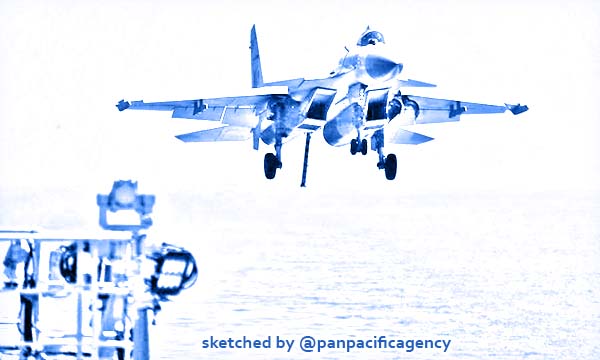In a first, Taiwan’s missile systems track Chinese fighter jets

A J-15 fighter jet of the PLA Navy prepares to land on China's aircraft carrier Liaoning during a naval exercise in the western Pacific. Photo: AFP. Sketched by the Pan Pacific Agency.
TAIPEI, Aug 11, 2020, SCMP. Taiwan for the first time tracked People’s Liberation Army fighters with surface-to-air missile radars on Monday, a tactic that could become more common in the future, an observer said, South China Morning Post reported.
The Taiwanese defence ministry said it used the systems to tail and expel the PLA J-10 and J-11 fighter jets, which crossed the “median line” of the Taiwan Strait – the unofficial airspace boundary between the island and the mainland.
The incident came as US Health Secretary Alex Azar started his landmark trip to Taiwan.
It is the first time the Taiwanese military has admitted using the ground-based anti-aircraft missiles during an interception.
But the island did not say which type of missile systems were involved, or whether the fire control radar was primed. Such a move would be more threatening and signal that the systems were ready to fire.
Taiwan has a number of land-based air defence missile systems, including US Patriot and Hawk missiles and its own Sky Bow series. They are deployed on the island and on Taiwan-controlled islands in the strait.
Hong Kong-based military commentator Song Zhongping said this might not be the last time the systems were deployed to track incoming aircraft.
“The Taiwanese air force has its air defence zone east of the strait median line, so it is natural they should switch on their air defence missile systems,” Song said.
“But the PLA does not recognise the line as a valid boundary and will continue to cross it as a ‘norm’ … so such a thing might recur in the future.”
He said it was unlikely that Taiwan would launch the missiles because that would mean the start of military conflict.
The J-10s and J-11s could also detect the tracking and take evasive action, including manoeuvring, jamming and deploying decoy flares.
“So this is more like a warning – it couldn’t pose much of a real threat to the PLA aircraft,” Song said.
Beijing claims sovereignty over Taiwan, and has not renounced the use of force to bring the island under its fold.
The PLA Air Force has mounted regular patrols around Taiwan in recent years, as it has dramatically modernised its fleet and ties with Taipei nosedived.
In April last year, two J-11 jets made the first intentional incursion across the median line in 20 years.
Monday’s show of Chinese military might came as Azar met Taiwanese President Tsai Ing-wen, in the highest-level visit by a US cabinet official to Taiwan since Washington switched diplomatic recognition from Taipei to Beijing in 1979.